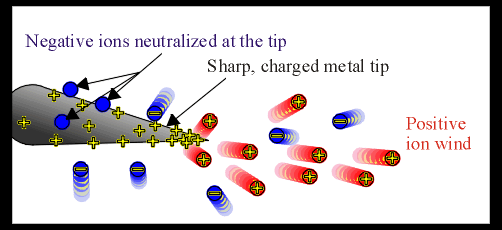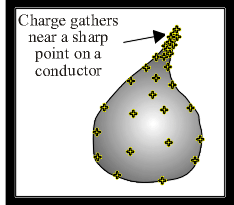The ion wind from the sharp tip of a charged conductor causes the conductor to move.
Teachable Topics:
- Static electric charge
- Ionization of air
Theory:
The electric charge on a conductor rests entirely on the outside surface. Moreover, electric charge tends to concentrate more heavily on sharp points and edges than on broad surfaces. Because this is so, the electric field near a sharp point on a conductor is stronger than near a broad surface. Sometimes this field can be so strong that it ionizes the air about the tip. The tip then attracts and neutralizes ions that have an opposite charge as that of the conductor. In addition, the tip repels like-charged ions. This repulsion of ions creates an electric "wind" that emanates from the tip.
The ion engine is a sharp-tipped propellor mounted on a stand and placed atop a charged Van de Graaff machine. The sharp tips quickly accumulate a strong positive charge. The positive ions repelled from the tip act as a jet to turn the propellor.
|
Figure 1: Tip of ion engine |

Apparatus:
- Van der Graaff Generator
- Ion engine
Procedure:
- Place the ion engine on the top of the generator as shown above
- Turn the generator on using the appropriate safety measures listed below
- Observe the rotation of the engine caused by the ion wind of the generator
- Turn off and discharge the generator safely
SAFETY WARNINGS:
- Make sure the Van de Graaff Generator is turned off before anyone touches it, otherwise the person risks getting shocked.
- Shocks through fingers and toes hurt the most. If you must discharge yourself without using the wooden stick, it's best to use a bent knuckle.
- Use the grounding rod to turn the generator on and off. After it is shut off, touch the rod to the to of the generator to remove any risidual charge.




